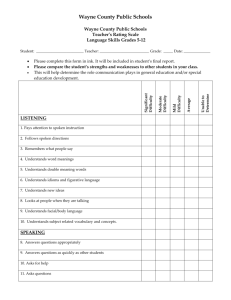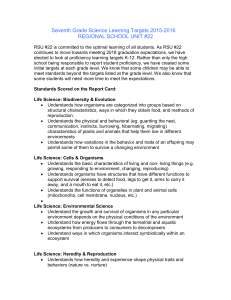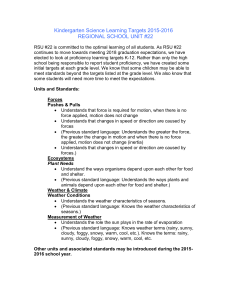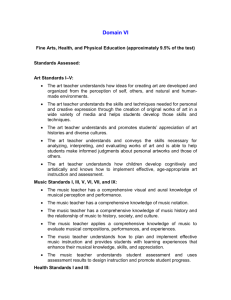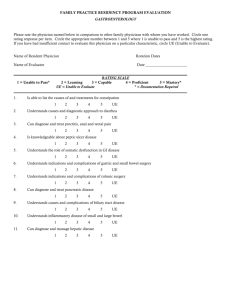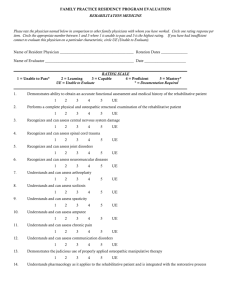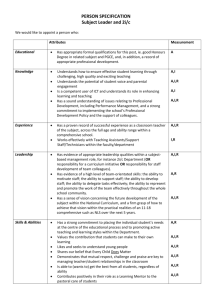Kansas Science Education Standards
advertisement
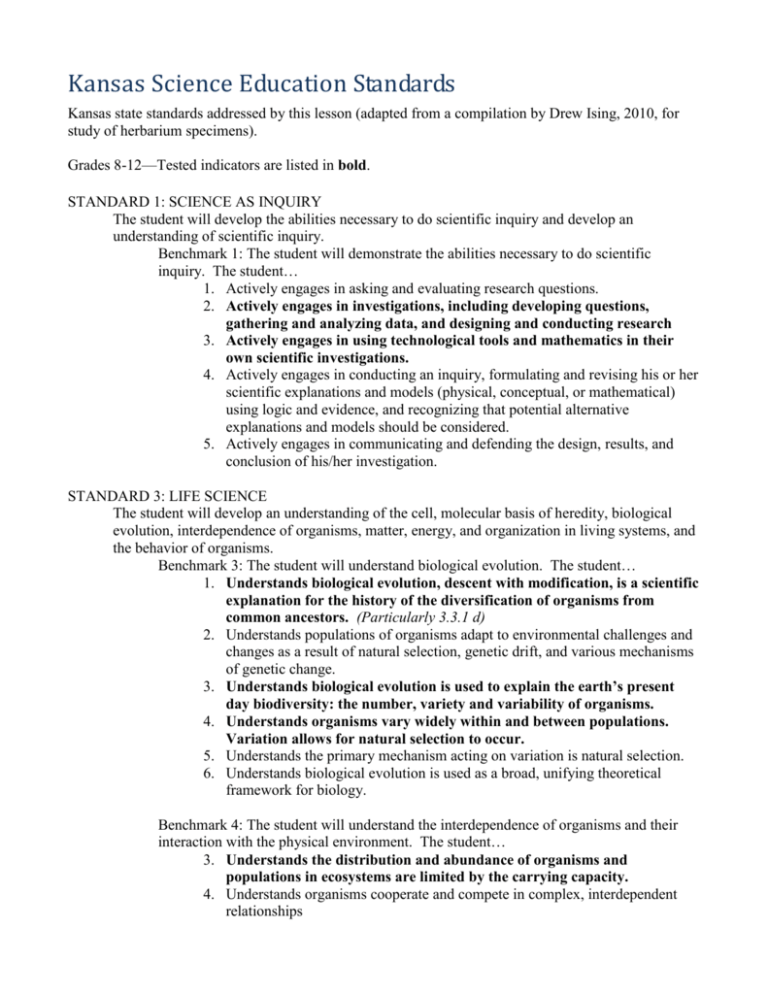
Kansas Science Education Standards Kansas state standards addressed by this lesson (adapted from a compilation by Drew Ising, 2010, for study of herbarium specimens). Grades 8-12—Tested indicators are listed in bold. STANDARD 1: SCIENCE AS INQUIRY The student will develop the abilities necessary to do scientific inquiry and develop an understanding of scientific inquiry. Benchmark 1: The student will demonstrate the abilities necessary to do scientific inquiry. The student… 1. Actively engages in asking and evaluating research questions. 2. Actively engages in investigations, including developing questions, gathering and analyzing data, and designing and conducting research 3. Actively engages in using technological tools and mathematics in their own scientific investigations. 4. Actively engages in conducting an inquiry, formulating and revising his or her scientific explanations and models (physical, conceptual, or mathematical) using logic and evidence, and recognizing that potential alternative explanations and models should be considered. 5. Actively engages in communicating and defending the design, results, and conclusion of his/her investigation. STANDARD 3: LIFE SCIENCE The student will develop an understanding of the cell, molecular basis of heredity, biological evolution, interdependence of organisms, matter, energy, and organization in living systems, and the behavior of organisms. Benchmark 3: The student will understand biological evolution. The student… 1. Understands biological evolution, descent with modification, is a scientific explanation for the history of the diversification of organisms from common ancestors. (Particularly 3.3.1 d) 2. Understands populations of organisms adapt to environmental challenges and changes as a result of natural selection, genetic drift, and various mechanisms of genetic change. 3. Understands biological evolution is used to explain the earth’s present day biodiversity: the number, variety and variability of organisms. 4. Understands organisms vary widely within and between populations. Variation allows for natural selection to occur. 5. Understands the primary mechanism acting on variation is natural selection. 6. Understands biological evolution is used as a broad, unifying theoretical framework for biology. Benchmark 4: The student will understand the interdependence of organisms and their interaction with the physical environment. The student… 3. Understands the distribution and abundance of organisms and populations in ecosystems are limited by the carrying capacity. 4. Understands organisms cooperate and compete in complex, interdependent relationships 5. Understands human beings live within and impact ecosystems. Benchmark 7: The student will demonstrate an understanding of the diversity of structure and function in organisms. The student… 1. Understands differences in structure and function among organisms and can identify the characteristics of relevant life forms. 2. Understands that homeostasis is the dynamic regulation and balance of an organism’s internal environment to maintain conditions suitable for survival. 3. Understands that living things change following a specific pattern of developmental stages called life cycles. 5. Understands taxonomy is the systematic way in which organism are placed into a hierarchical classification system, according to their physical and genetic characteristics and their evolutionary history. STANDARD 5: SCIENCE AND TECHNOLOGY The student will develop understandings about the relationship between science and technology. Benchmark 1: The student will develop an understanding that technology is applied science. The student… 1. Understands technology is the application of scientific knowledge for functional purposes. 2. Understands creativity, imagination, and a broad scientific knowledge base are required to produce useful results. 3. Understands science advances new technologies. New technologies open new areas for scientific inquiry. STANDARD 6: SCIENCE IN PERSONAL AND ENVIRONMENTAL PERSPECTIVES The student will develop an understanding of personal and community health, population growth, natural resources, environmental quality, natural and human-induced hazards, and science and technology in local, national, and global settings. Benchmark 2: The student will demonstrate an understanding of population growth. The student… 1. Understands the rate of change in populations is determined by the combined effects of birth, death, emigration, and immigration. 3. Understands populations have limits to growth. Benchmark 5: The student will develop an understanding of the relationship between science, technology, and society. The student… 1. Understands progress in science and technology can be affected by social issues and challenges. Science and technology indicate what can happen, not what should happen. STANDARD 7: HISTORY AND NATURE OF SCIENCE The student will develop understanding of science as a human endeavor, the nature of scientific knowledge, and historical perspectives. Benchmark 1: The student will develop an understanding that science is a human endeavor that uses models to describe and explain the physical universe. The student… 1. Demonstrates an understanding of science as both vocation and avocation. 2. Explains how science uses peer review, replication of methods, and norms of honesty. 6. Recognizes society’s role in supporting topics of research and determining institutions where research is conducted. Benchmark 2: The student will develop an understanding of the nature of scientific knowledge. The student… 1. Understands scientific knowledge describes and explains the physical world in terms of matter, energy, and forces. Scientific knowledge is provisional and is subject to change as new evidence becomes available. 2. Understands scientific knowledge begins with empirical observations, which are the data (also called facts or evidence) upon which further scientific knowledge is built. 3. Understands scientific knowledge consists of hypotheses, inferences, laws, and theories. 4. Understands a testable hypothesis or inference must be subject to confirmation by empirical evidence
